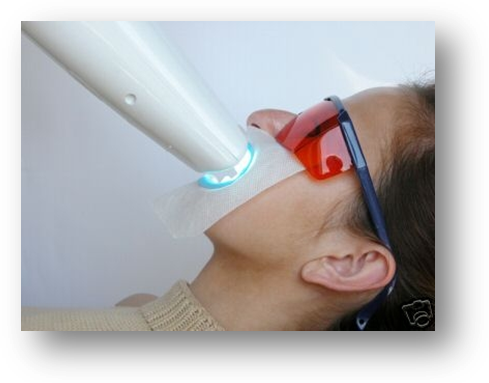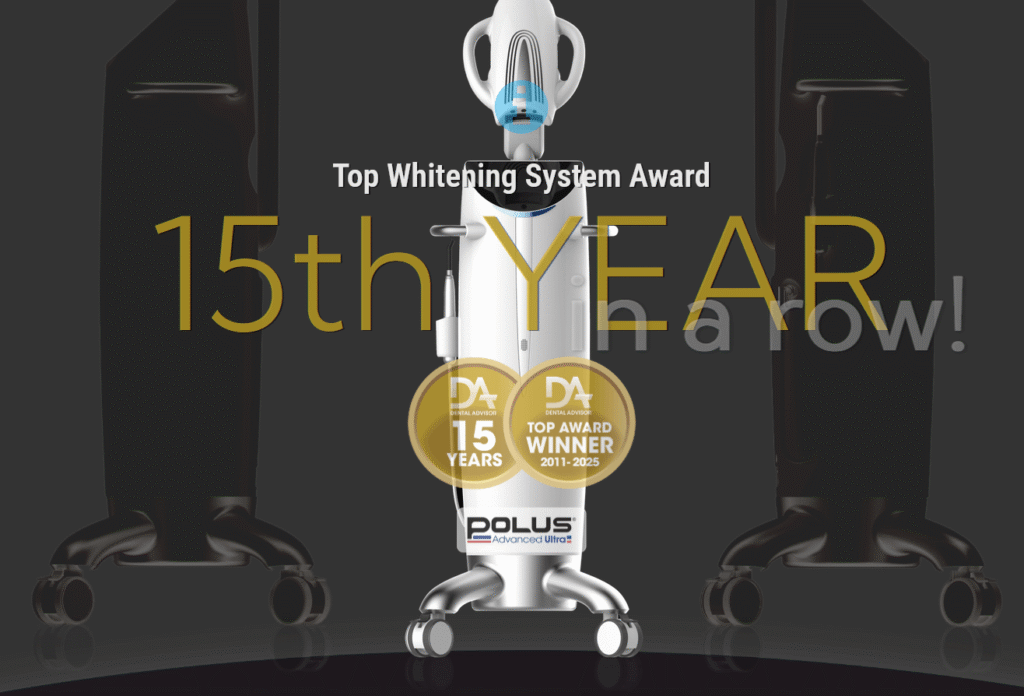
Beyond Polus Advanced vs Philips Zoom: Which whitening system is best for dental clinics?
Choosing Between the Top Two Whitening Systems for Dental Clinics
When it comes to in-chair teeth whitening, two systems stand out as the industry leaders: the Beyond Polus Advanced and the Philips Zoom WhiteSpeed. Both are trusted by dental professionals around the world and promise fast, effective results for patients wanting a whiter smile in a single visit.
But while they share a similar goal, these systems are built quite differently — from the type of light they use, to how comfortable the treatment feels for patients, to the overall cost of running them in a busy clinic.
In this article, we break down the key differences between Polus and Zoom, feature by feature, to help you decide which system is best for your dental practice.
1. Technology & Light Output
Beyond Polus Advanced
The Polus Advanced system uses a combination of three light sources — LED, halogen, and filtered UV — making it one of the most powerful systems available. It produces up to 200,000 lux, which helps break down stains faster and more effectively.
What makes Polus truly unique is its ultrasonic technology. This feature sends strong but gentle vibrations through the whitening gel, helping it work deeper and faster — with less heat and sensitivity for the client.
The machine also has smart filters to block any harmful light and lets you adjust settings depending on the client’s needs — whether they have sensitive teeth or want a more intense result.
Philips Zoom WhiteSpeed
Zoom WhiteSpeed uses LED light only, with three intensity settings (low, medium, high). It’s designed specifically to activate Zoom’s hydrogen peroxide gel and works best in dental clinics where control and consistency matter most.
While it doesn’t have ultrasonic power or multiple light types, it’s a trusted and simple system that delivers good results in around 45 minutes.
2. Treatment Time & Session Flow
Beyond Polus Advanced
Polus Advanced treatments take 36 to 45 minutes, depending on the client’s needs and their level of staining on their teeth. The session is broken into three shorter rounds (usually 12–15 minutes each), which makes it easier to manage sensitivity and check progress in between.
Because the machine uses ultrasonic energy and a powerful light, results often show faster, so some clients may not need the full time. The operator has full control and can pause or adjust settings during the treatment.
This flexibility makes Polus a good option for clients who are nervous, sensitive, or short on time.
Philips Zoom WhiteSpeed
Zoom treatments usually take a fixed 45 minutes, broken into four rounds of 15 minutes each. The process is more structured and follows a set routine.
There’s not as much flexibility built into the session, so if a client feels sensitivity halfway through, they may need to stop altogether — or push through.
Zoom’s structure makes it simple to use and consistent from one client to the next, which works well in busy dental clinics that need a predictable workflow.

3. Sensitivity & Client Comfort
Beyond Polus Advanced
Polus Advanced is known for being gentler on sensitive teeth, thanks to its unique combination of smart light filtering and ultrasonic technology. The system filters out heat and UV rays that can cause irritation, and the ultrasonic feature helps the gel break down stains faster without needing intense light or heat.
The whitening gel used — such as Beyond OSMO — includes desensitising ingredients like glycerin and sodium phytate, designed to protect the enamel and gums. The feedback from many New Zealand clinics using the Polus is that clients experience minimal post-treatment sensitivity, even when whitening to higher levels.
This makes it a strong choice for clients who’ve had issues with sensitivity before, or who are nervous about discomfort.
Philips Zoom WhiteSpeed
Zoom WhiteSpeed is effective — but it’s also known for causing higher levels of sensitivity during and after treatment. The LED light activates the hydrogen peroxide gel quickly, but the intense reaction can trigger “zingers” — sharp, electric-like pains in the teeth — particularly in clients with thin enamel or exposed roots.
Philips acknowledges this in their professional training materials, noting that post-treatment discomfort is common and that a desensitising gel is included in the protocol to help manage it.
While Zoom delivers powerful results, clients often report lingering sensitivity for 12–24 hours afterward, especially when all four sessions are completed at full intensity.
4. Cost & Ongoing Expenses
Beyond Polus Advanced
For dental clinics looking to offer premium whitening services, the Beyond Polus Advanced sits in the $7,500–$8,000 NZD range. While that’s a significant upfront investment, it’s on par with other top-tier in-office systems.
The per-treatment cost typically ranges from $35–$65 NZD, depending on whether the clinic already stocks some of the necessary consumables (like cheek retractors and bibs) and what Beyond whitening kits they wish to use. This cost includes:
- Beyond’s OSMO whitening gel (dual syringe) OR dental whitening kit
- Gingival barrier gel
- Single-use applicators
- Protective covers and accessories
It’s important to note that Beyond whitening gels require refrigeration, so clinics will need to store them properly to maintain product integrity. The shelf life is long when stored correctly, which helps minimise waste.
Clinics can typically price Polus treatments between $299–$499, depending on their location and patient base, offering a solid margin even after consumables are factored in.
Philips Zoom WhiteSpeed
The Zoom WhiteSpeed system is priced in a similar range — typically between $7,000 and $8,000 NZD, depending on supplier pricing and whether a bundled starter kit is included.
Zoom’s per-patient consumable costs are generally higher, averaging $50–$70 NZD per treatment. This includes:
- Zoom proprietary hydrogen peroxide gel syringes
- Desensitising relief gel
- Gingival barrier
- Vitamin E swabs
- Cheek retractors
- Disposable accessories (brush tips, trays, etc.)
Because Philips requires the use of their own branded kits, clinics can’t easily substitute with third-party consumables. This keeps clinical consistency high, but also locks practices into a higher cost per use.
Zoom whitening is often charged at $399–$599 in New Zealand dental clinics, so while margins can be strong, profitability depends on pricing discipline and patient volume.
5. Usability & Customisation for Clinics
Beyond Polus Advanced
Polus Advanced is designed for flexibility and clinical control. The unit features a touchscreen interface, making it easy to adjust treatment settings based on patient sensitivity, shade goals, or specific protocols.
Clinicians can choose between different light intensity levels and modes, including options tailored for patients with high sensitivity or previous whitening treatments. The system also includes a built-in air purification unit and cooling fan to enhance comfort during use.
The movable, floor-standing design and adjustable light arm make it easy to position the machine around the dental chair, especially useful in practices where chair-side flexibility matters. Several NZ dentists using the Polus report that they like having more hands-on control during the whitening process.
Philips Zoom WhiteSpeed
Zoom WhiteSpeed is built for simplicity and standardisation. It has three light intensity settings (low, medium, high) and a step-by-step protocol that’s consistent for every patient.
While there’s less room for customisation, this structure works well in busy clinics that want reliable results with minimal setup. The machine includes a pre-programmed timer for each of the four 15-minute rounds, and the operator doesn’t need to make many adjustments once treatment starts.
Its compact, wheeled base is easy to manoeuvre around the chair, and the adjustable lamp arm locks securely into place for precise targeting of the treatment area.
Clinics offering Zoom tend to value its predictability and ease of use, especially where several staff members may rotate whitening duties.
6. Results & Patient Satisfaction
Beyond Polus Advanced
The Polus Advanced is known for delivering impressive whitening results, often achieving a 6–8 shade improvement in just one visit. Thanks to the combination of ultrasonic energy and multi-light output, the system helps the gel penetrate deeper into the tooth surface, lifting both surface and deeper stains effectively.
Many clinics report that clients notice visible changes after the first cycle, with full results showing by the end of the 36-minute treatment. According to feedback from Polus providers in NZ and overseas, clients also report less post-treatment sensitivity, which leads to a more positive overall experience and increases the chance of referrals and repeat bookings.
For dentists, this balance between strong results and reduced discomfort makes the Polus a solid choice for both cosmetic-focused and general practice settings.
Philips Zoom WhiteSpeed
Zoom is a well-recognised brand that patients often ask for by name, especially those familiar with dental whitening. It typically delivers a 5–7 shade improvement, depending on the starting colour and how many 15-minute sessions are completed.
Results are often immediate, which is a key selling point, but as mentioned earlier, Zoom is also associated with higher levels of sensitivity — sometimes lasting 24–48 hours. Despite this, many patients are happy with the whitening outcome, especially when they understand what to expect.
Because it’s marketed heavily through dental clinics, Zoom still carries a strong perception of clinical strength and trust, which can be appealing for practices wanting to promote a well-known brand.

So, which whitening system is best for your dental clinic?
Both the Beyond Polus Advanced and Philips Zoom WhiteSpeed are powerful, clinic-grade whitening systems — but they serve slightly different needs.
If your clinic is focused on clinical efficiency, brand familiarity, and structured protocols, Philips Zoom WhiteSpeed is a solid choice. It’s a well-known system with a consistent workflow that suits busy dental practices. However, the higher consumable costs and greater chance of post-treatment sensitivity are factors to consider, especially for practices with more sensitive or cautious patients.
On the other hand, the Beyond Polus Advanced offers a clear advantage in several key areas:
- Greater flexibility in treatment settings and light modes
- Reduced patient sensitivity due to ultrasonic action and smart light filtration
- Strong whitening results, often visible after just one round
- Lower long-term consumable costs, especially for clinics already stocked with basic accessories
- And critically, it delivers a more comfortable patient experience, which can improve satisfaction, repeat visits, and referrals
For dental clinics that want a premium in-office whitening system with more clinical control, better margins, and higher patient comfort, the Beyond Polus Advanced stands out as the more versatile and forward-thinking option.
Plus…the Polus Advanced Ultra has been awarded the Top Whitening System Award by the Dental Association for 15 years running, from 2011 to 2025. You can’t get much better than that!
What now?
If you’re interested in the Polus Advanced Ultra whitening machine for your dental clinic, you can find out more about it HERE.
Feel like some more research? This scientific study on dentin sensitivity is for dental professionals who are interested in treating dentin sensitivity in patients, or those looking to expand their knowledge of different treatment options for dentin sensitivity and the role of specific ingredients in aiding this.